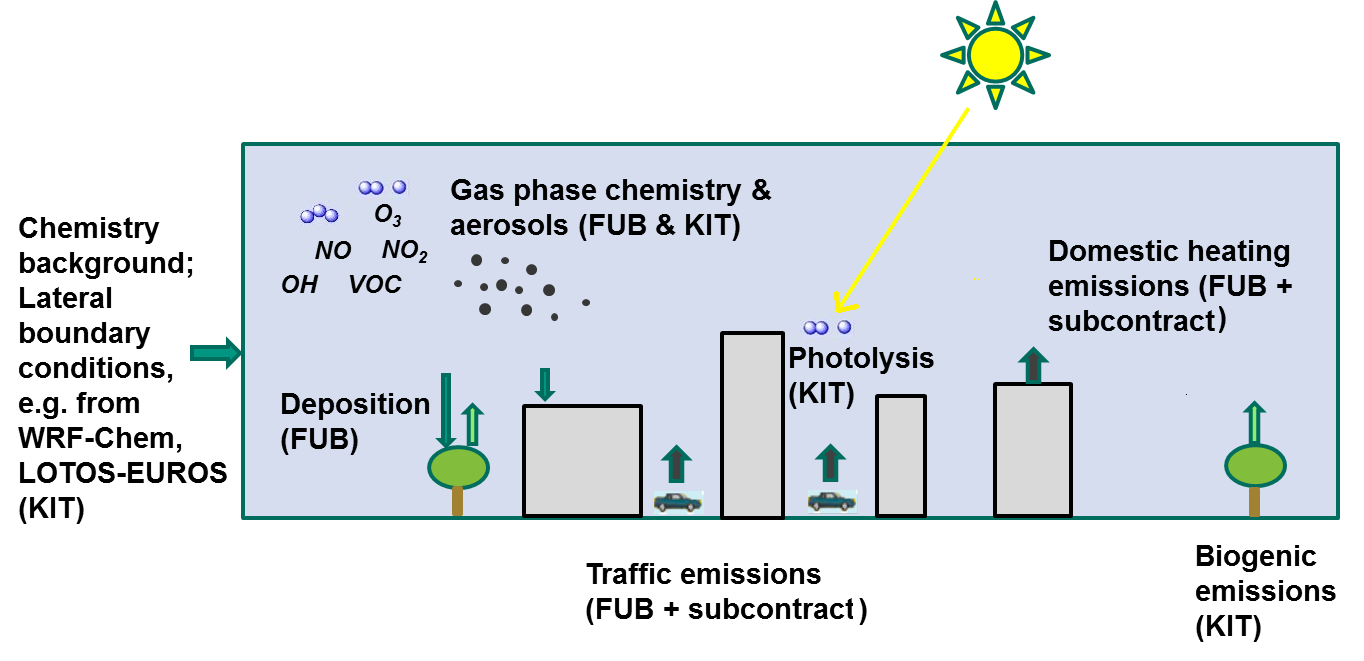Work package M7: Urban chemistry and air pollution
Contact information
Principal investigators:
Dr. Matthias Mauder  ,
Dr. Renate Forkel
,
Dr. Renate Forkel 
Staff: Dr. Basit Khan
Institution: KIT/IMK-IFU, Garmisch-Partenkirchen (http://www.imk-ifu.kit.edu/projects_2442.php)
Principal investigators:
Dr. Sabine Banzhaf  ,
Prof. Dr. Uwe Ulbrich
,
Prof. Dr. Uwe Ulbrich 
Staff: Dr. Emmanuele Russo
Institution: Freie Universität Berlin, Institut für Meteorologie (http://www.geo.fu-berlin.de/met/index.html)
Goals of WP-M7
Poor air quality in urban areas due to strong anthropogenic emissions has a negative effect on human health and well-being. In order to apply the PLAM4U modelling system for air quality analysis and mitigation studies the transport and chemical transformation of atmospheric pollutants in the gas phase and aerosols need to be included. The primary goal of work package WP-M7 is to develop and evaluate online coupled chemistry modules with different complexity: a more simple chemistry scheme for the LES mode, where turbulence at street level is described in detail, and a more complex chemistry, which can applied in combination with the RANS mode. Besides the chemistry schemes themselves, also additionally required modules and input, such as photolysis (dissociation of molecules by solar radiation), boundary conditions, or anthropogenic and biogenic emissions are developed within WP-M7. Within this work package efforts will be shared among Karlsruhe Institute of Technology (KIT) and Free University Berlin (FUB). The model will be tested for Berlin. The required emission inventories, in particular for traffic and domestic heating emissions, are developed in subcontracts. |
Work program
The first step of the development of an atmospheric chemistry module for LES is the implementation of additional Eulerian scalars for multiple chemical species including their respective source and sink terms. Next, a photo-stationary equilibrium NO-NO2-O3-VOC chemistry is implemented, and then a simple nitrate-ammonium-sulfate equilibrium system is included. A parameterized photolysis is formulated using radiation information available in the model.
In addition, an atmospheric chemistry model for the RANS mode is included, and deposition processes are implemented. After the adaptation of an already existing gas-phase chemistry mechanism, a sufficiently complex scheme is established considering secondary inorganic and organic aerosols. Processes of dry deposition and wet removal are included in the newly developed model. The results are compared with the chemistry module for the LES mode.
Adequate representation of the boundary conditions is crucial for a realistic simulation of chemical processes in the urban environment. Therefore, an Interface with a mesoscale atmospheric chemistry model is created in order to provide the lateral boundary conditions. Land use data and biogenic emissions are prepared for use in the new urban climate model.
Other important input data are made available through consolidation and temporal disaggregation of anthropogenic emissions into a consistent data set that can be used as input for the chemistry module. Then, the two modules can be tested, first technically and afterwards for validity by using real-world data. Furthermore, the new modules will be optimized for speed on parallel computers. Finally, applications are intended to simulate the effects of different emission reduction strategies on urban air quality.
Attachments (1)
- WPM7_fig1_en.png (85.2 KB) - added by kanani 8 years ago.
Download all attachments as: .zip




